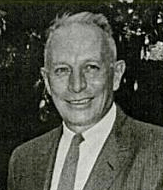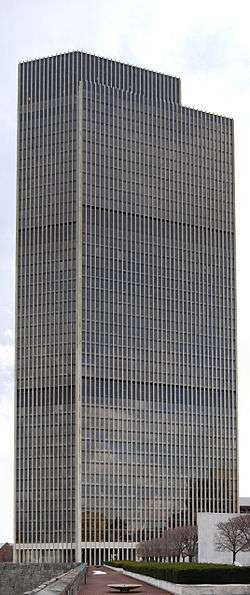Erastus Corning 2nd
| Erastus Corning 2nd | |
|---|---|
 Mayor Corning in 1964 | |
| 72nd Mayor of Albany, New York | |
|
In office January 2, 1942 – May 28, 1983 | |
| Preceded by | J. Boyd Thatcher II |
| Succeeded by | Thomas M. Whalen III |
| Member of the New York Senate from the 30th district | |
|
In office January 1, 1937 – August 1, 1941 | |
| Preceded by | William T. Byrne |
| Succeeded by | Julian B. Erway |
| Member of the New York State Assembly from Albany's 1st district | |
|
In office January 1, 1936 – August 1, 1937 | |
| Preceded by | John H. Cahill |
| Succeeded by | George W. Foy |
| Personal details | |
| Born |
Erastus Corning II October 7, 1909 Albany, New York, U.S. |
| Died |
May 28, 1983 (aged 73) Boston, Massachusetts, U.S. |
| Political party | Democratic |
| Spouse(s) | Elizabeth Platt |
| Children |
Erastus Corning III Bettina Corning Dudley |
| Alma mater | Yale University |
| Profession | Insurance broker |
| Military service | |
| Allegiance |
|
| Service/branch | United States Army |
| Years of service | 1944–1945 |
| Battles/wars | Second World War |
Erastus Corning 2nd (October 7, 1909 – May 28, 1983) was an American politician. He was Mayor of Albany, New York for more than 40 years, from 1942 to 1983, when Albany County was controlled by one of the last two classic urban political machines in the United States. Albany's longest-serving mayor, the Democrat died in office in 1983. His great-grandfather, Erastus Corning, was an industrialist who founded the New York Central Railroad and served as Albany's mayor from 1834 to 1837. His father, Edwin Corning, was Lieutenant Governor of New York from 1927 to 1928.
Name
Corning referred to himself as "Erastus Corning 2nd", preferring that moniker to "Erastus Corning II".[1][2]
Life and career
Corning was born in Albany, New York, the son of Louise (née Maxwell) and Edwin Corning. His mother was born in Cawnpore, India, where her father was serving as a missionary, to American parents.[3] He was educated at The Albany Academy and Groton School before attending Yale University. After earning his college degree, Corning started an insurance company and soon entered politics. He was a member of the New York State Assembly (Albany Co., 1st D.) in 1936; and of the New York State Senate (30th D.) from 1937 to 1941, sitting in the 160th, 161st, 162nd and 163rd New York State Legislatures. He resigned his seat on August 1, 1941, to seek the Democratic nomination for Mayor of Albany.[4]
Corning won the first of his 11 terms as mayor in November 1941 – easily defeating the Republican candidate, Benjamin R. Hoff, by nearly 46,000 votes. Corning took office on January 1, 1942, and was re-elected in landslides for most of the rest of his tenure. The most notable exception was 1973 when a prominent businessman and reform candidate, Carl Touhey, ran a well-financed campaign and came within 3,200 votes of defeating the mayor. In 1977 Corning weathered a primary election challenge from State Senator Howard C. Nolan, Jr.
Touhey's campaign was not the first major challenge to Corning's administration. Shortly after his first term began, the newly elected Governor Thomas E. Dewey had the powerful Albany Democratic political machine, run by "Boss" Daniel P. O'Connell, investigated. The investigations proved largely unsuccessful and left Corning and O'Connell unscathed. This political machine proved to be one of the most durable in American history, even outlasting the Daley family machine in Chicago.
During Governor Dewey's investigation, Corning was drafted into the United States Army and served as a private in World War II; he did not seek to use his official status to avoid service or to get any favorable treatment. During his absence, Frank Harris, a councilman, served as acting mayor, appointed to this post by Corning.
At the New York state election, 1946, Corning ran for Lieutenant Governor of New York with James M. Mead for governor, but they were defeated by the incumbent Republicans Dewey and Joe R. Hanley.
Corning served ten full consecutive terms after his return from the war. His insurance firm profited from being the sole bidder on Albany County insurance contracts for many years. Corning defended this apparent conflict of interest by noting that he himself was not a county official.
His last mayoral re-election came in 1981. During his last term he began to show health problems and, on May 28, 1983, he died of heart failure at University Hospital in Boston. He is interred in Albany Rural Cemetery.
Legacy
The Erastus Corning Tower, the tallest building in Albany and the tallest in the state outside New York City, is named for him, as is the "Corning Preserve", a nature trail and fishing site on the western banks of the Hudson River in Albany. The tower is part of the Empire State Plaza, a 98-acre (400,000 m2), 11-building state government office and cultural complex. Some believe that the building was named after Corning because it has 42 floors (which is the same as the number of years he served as mayor), but the building actually has 44 floors with an observation deck on Floor 42. Completed in 1973, the skyscraper was dedicated to Corning upon his death in 1983.
Awards and honors
Queen Wilhelmina of the Netherlands named Corning an officer of the Order of Orange-Nassau, the country's highest citizen honor, in gratitude for his aid to Nijmegen following World War II.[5]
References
- ↑ O Albany!, by William Kennedy, 1983, page 329
- ↑ Mayor Corning: Albany Icon, Albany Enigma, by Paul Grondahl, 2007, page 69
- ↑ http://freepages.genealogy.rootsweb.ancestry.com/~battle/senators/gillibrand.htm
- ↑ CORNING TO RUN IN ALBANY; State Senator Resigns to Seek the Mayoralty in the New York Times on August 2, 1941 (subscription required)
- ↑ "Dutch make royal return". Albany Times Union. September 4, 2009.
External links
- Excerpt from Mayor Corning: Albany Icon, Albany Enigma by Paul Grondahl
- Another excerpt from Mayor Corning: Albany Icon, Albany Enigma
- Biography of Erastus Corning 2nd at Albany County Hall of Records
- Erastus Corning 2nd at Find a Grave
| New York Assembly | ||
|---|---|---|
| Preceded by John H. Cahill |
New York State Assembly Albany County, 1st District 1936 |
Succeeded by George W. Foy |
| New York State Senate | ||
| Preceded by William T. Byrne |
New York State Senate 30th District 1937–1941 |
Succeeded by Julian B. Erway |
| Political offices | ||
| Preceded by Herman F. Hoogkamp |
Mayor of Albany, New York 1942–1944 |
Succeeded by Frank Salisbury Harris Acting |
| Preceded by Frank Salisbury Harris Acting |
Mayor of Albany, New York 1945–1983 |
Succeeded by Thomas Michael Whalen III |
| Party political offices | ||
| Preceded by Charles Poletti 1942 |
Democratic Party Nominee for Lieutenant Governor of New York 1946 |
Succeeded by Richard H. Balch 1950 |
